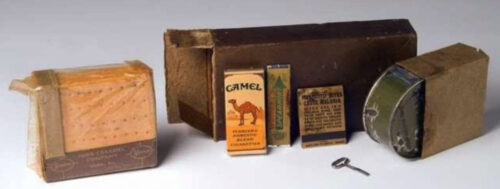The Cracker Caper
Yokosuka—Japan 1949
(For dinner tonight: a K-Ration package with tasty components on display).
Editor’s Note: This tale of Japan under the American Occupation is told by Tom “Big Smoke” Duvall. He sent it to former Director of Naval Intelligence RADM T.A. Brooks fifteen years ago. He shared it with us. Big Smoke was one of the heroes of our trade of skullduggery. He entered a global conflict as a young sailor in 1944. His youth and sense of adventure made him stay in the Service as millions of others returned home to build a new life in a new world. Like our pal Admiral Mac Showers, he had no pre-war job to return to when the guns went silent. And so they invented a new world. Join us this morning for a ‘taste’ of what it was like. Tom took counter-intelligence courses from the Marines, and qualified for assignment- in plain clothes- as Chief of the Yokosuka Police
– Vic
The Cracker Caper

When WW2 ended the Navy ships in Yokosuka off-loaded all the ammunition and stores they could. I was told of a warehouse that had tons of old K-Rations and if I could think of any use to help myself.
The K ration was a box about the size of a box of Crackerjacks. It had a couple of tins of food, cigarettes, packets of sugar/coffee, and what looked like round crackers; but had become very hard.
I picked up a couple of cases and took them out to my police squad. My chief of detectives rationed them out and the men went wild opening them up and binging on the contents. It was great since they offered me their bowls of noodles in exchange. My Japanese assistant told me the chatter in the squad-room was that now they knew why US troops were so good. They were so well fed.
At this point I did not know that my Chief of Detectives had been a Master Sergeant in Manchuria and that the whole team had prior military service. The Chief of police thought they would be best since we would primarily be working on cases relating to the military.
One day my assistant came in and said the men could use some more K-Rations. I asked him “To Eat?”
He responded that was good, but that “The biscuits proved very useful.”
That was when he took me in and showed me the prisoner they had been trying to make talk. That was when I took this picture:

When the US Navy occupied the Yokosuka base the first thing they had to do was seal all the tunnels, not only on the base but those leading off. It was a rabbit warren of tunnels and underground spaces. The only one left open was next to the HQ building.
Since it was the main Navy Command Center of the Japanese Navy, they liked to show it off.
Japan had been stripped of all metal and now anything like copper or other such metals brought high prices on the black market. Employees entering the base had lockers where they changed clothes, both entering and leaving the base. All under base police supervision.
Our prisoner was just finishing a stack of K-Rat crackers
Before starting, he had missed a couple of meals. Once he had finished his meal of crackers, some of my team gathered around loudly sipping their tea. I always thought it amazing how thirsty one had to be before they got very talkative in exchange for a sip of water.
During the war all of the wood structures had gone from the fire raids. When the war ended, they were rapidly rebuilt. One was right over a tunnel entrance leading into the base. The owner made good pocket change renting his entrance.
A bulldozer and truck of cement solved that problem.
Our little friend loved the crackers so well that he was very useful in introducing us to his friends and associates.
I would have liked to have sent a thank you letter to the manufacturer of the K-Rations but I could not find an address on the box.
We were under Martial Law then, but today I probably would be getting a General Courts Martial.
I doubt the Naval Historical Center would like this. It was just the way it was.
Copyright 2023 Vic Socotra
www.vicsocotra.com
